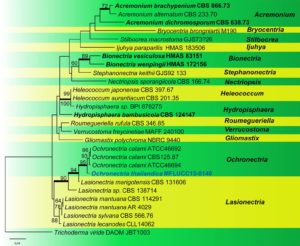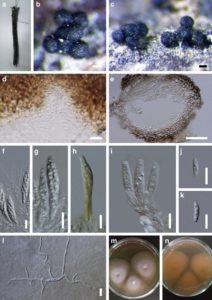Ochronectria thailandica Q.J. Shang, D.Q. Dai & K.D. Hyde, sp. nov., Index Fungorum number: IF 551918
Etymology: The specific epithet ‘thailandica’ refers to the country where the fungus was first collected.
Saprobic on bark. Sexual morph Ascomata 71–189 μm high, 78–223 diam., solitary to gregarious, superficial, black, globose, cup-like, or collapsing laterally when dry. Ostioles brown to dark brown, 28–32 μm diam., with araphyses. Peridium 31–52 μm wide, composed of three layers, inner 1–3 layers, comprising of hyaline, thin-walled, elongated cells, central 3–4 layers of yellow to brown cells arranged in a textura angularis, outer 5–6 layers, comprising dark brown to black, thick-walled cells of textura angularis to globosa, having yellow oily droplets between the cells. Hamathecium comprising 1.2–3 μm wide, hyaline, aseptate paraphyses. Asci 34–56 × 6–9 μm (x = 45×7μm, n = 30), 8-spored, unitunicate, clavate, with short pedicel, slightly rounded to truncate at the apex. Ascospores 12–17 × 3–4 μm (x =14 ×3μm, n=50), overlapping 2-seriate, fusiform, hyaline, 2-celled, straight to curved, smooth-walled, with small guttules. Asexual morph Undetermined.
Culture characteristics: Ascospores germinating on MEA within 24 h. Germ tubes produced from any cell. Colonies on MEA reaching 1.5–2 mm diam. after 7 d in the dark at 25 °C, edge entire, flat or effuse or umbonate, sparse, forming ascomata on MEA in the centre. After 7 d colonies white (n) above, from below reddish yellow (o).
Material examined: THAILAND, Chiang Rai, Mae Sai, Pong Ngam Village, Tham Pla Cave, on unidentificated
wood in the water, 25 November 2014, Qiu Ju Shang, SHTM02–4 (MFLU 16–0030, holotype), ex-type living culture, MFLUCC 15–0140, (isotype in KUN-HKAS, under the code of KUN-HKAS 93730), ex-living culture
KUMCC 16-0001).
Notes: Based on phylogenetic analyses and morphological comparison, our isolate belongs to the genus Ochronectria in the family Bionectriaceae. The morphology of Ochronectria thailandica fits well with the description provided by
Rossman and Samuels (1999). It differs from the type, O. calami (Henn. & E. Nyman) Rossman & Samuels and O. courtecuissei Lechat based on the size and colour of ascomata, peridium colour and number of septa and imensions of the ascospores. Ochronectria thailandica has black ascomata, a peridium composed of black brown outer layers and yellow middle layers, while, O. calami has white or yellow to orange ascomata, a peridium composed of hyaline middle and outer layers, and O. courtecuissei has yellow to brown ascomata and a peridium composed of yellow to orange outer layers and hyaline middle layers (Rossman et al. 1999, 2001; Lechat 2010). Furthermore, O. thailandica, which has 1-septate ascospores can be distinguished from O. calami which forms multi-septate ascospores. Phylogenetic analysis based on LSU sequence data of the family Bionectriaceae showed that O. thailandica is closely related to O. calami, forming a distinct lineage within the sclade (Fig. 1).
Fig. 1 Phylogram generated from maximum likelihood analysis based on LSU sequence data of the family Bionectriaceae. New taxa are in blue ex-type strains are in bold. The tree is rooted with Trichoderma viride.

Fig. 2 Ochronectria thailandica (holotype) a Host b, c Ascomata on host d Vertical section of ascoma e Periphysate ostiole f Section of peridium g Paraphyses and asci h–j Asci; note i stained in Melzer’s reagent k, l Ascospores m Germinating ascospore n, o Culture on MEA. Scale bars: b, c = 100 μm, d = 25 μm, e, g–l = 10 μm, f, m = 20μm.

